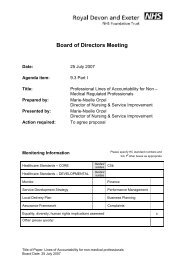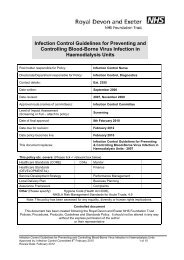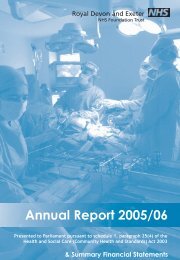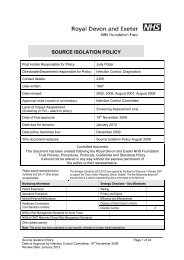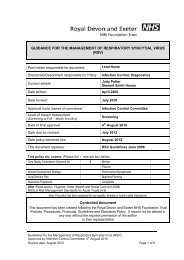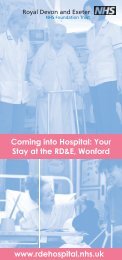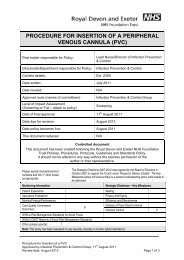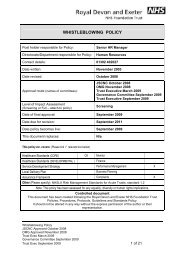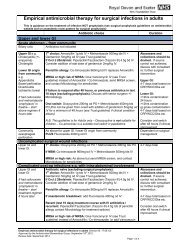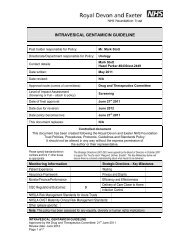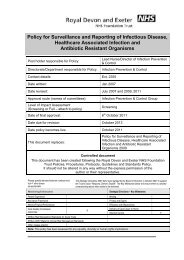Annual Report and Accounts 2012/13 - Royal Devon & Exeter Hospital
Annual Report and Accounts 2012/13 - Royal Devon & Exeter Hospital
Annual Report and Accounts 2012/13 - Royal Devon & Exeter Hospital
Create successful ePaper yourself
Turn your PDF publications into a flip-book with our unique Google optimized e-Paper software.
20 2. Progress on our<br />
<strong>2012</strong>/<strong>13</strong> Priorities<br />
<strong>Royal</strong> <strong>Devon</strong> <strong>and</strong> <strong>Exeter</strong> NHS Foundation Trust<br />
Quality <strong>Report</strong> <strong>2012</strong>/<strong>13</strong><br />
Patients with complex needs<br />
Patients with complex ongoing needs<br />
require more focused assistance to<br />
enable them to leave hospital. We are<br />
working with our partners – social<br />
care, health <strong>and</strong> the voluntary sector<br />
– to raise awareness amongst staff,<br />
patients <strong>and</strong> their carers of the support<br />
services available to people after<br />
leaving hospital.<br />
Pharmacy discharge<br />
In the past, one of the factors that held<br />
up patients leaving hospital was the<br />
delay in being prescribed or obtaining<br />
medication to take home. As a result,<br />
we have redesigned our processes to<br />
ensure that medication is provided as<br />
quickly as possible <strong>and</strong> any delays dealt<br />
with as quickly as possible, enabling<br />
patients to go home sooner.<br />
When ward staff are ready to discharge<br />
a patient, they can now use our<br />
‘discharge bleep service’. A member<br />
of pharmacy staff will go to the ward<br />
to check the discharge summary. This<br />
enables face to face communication<br />
with medical <strong>and</strong> nursing staff to<br />
resolve any issues <strong>and</strong> ensure the right<br />
items are dispensed, reducing waste<br />
<strong>and</strong> drastically reducing any delay. The<br />
drug chart does not leave the ward,<br />
contributing to improved patient<br />
safety. Average turnaround times are<br />
greatly reduced: in January 20<strong>13</strong>, 70%<br />
of drugs to take home were dispensed<br />
in less than one hour <strong>and</strong> 93% in less<br />
than two.<br />
Improve patient flow when<br />
patients come to the RD&E for<br />
planned surgery<br />
Last year we said we were looking<br />
at all our planned surgical services<br />
across the hospital to develop ways of<br />
improving patient experience by being<br />
more efficient. Our aim was to provide<br />
smooth co-ordinated services from<br />
diagnosis <strong>and</strong> preparation of surgery<br />
through to recovery <strong>and</strong> leaving<br />
hospital.<br />
Review of bed numbers<br />
The RD&E has seen a year on year rise<br />
of around 7% in emergency medical<br />
admissions. Many of these patients<br />
are aged 80 years <strong>and</strong> over <strong>and</strong> have<br />
complex health problems. Over the last<br />
two winters the Trust has struggled<br />
to balance the number of emergency<br />
admissions with patients being<br />
discharged, resulting in bed shortages.<br />
The national recommendation is for<br />
acute hospitals to run on an average<br />
85% bed occupancy – but we were



